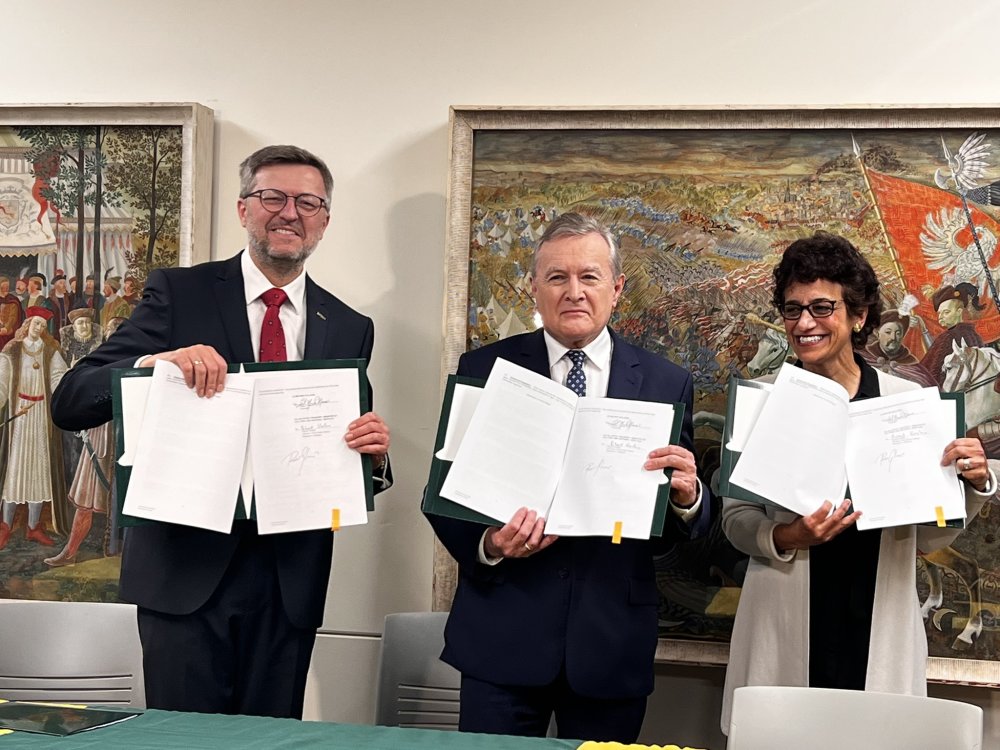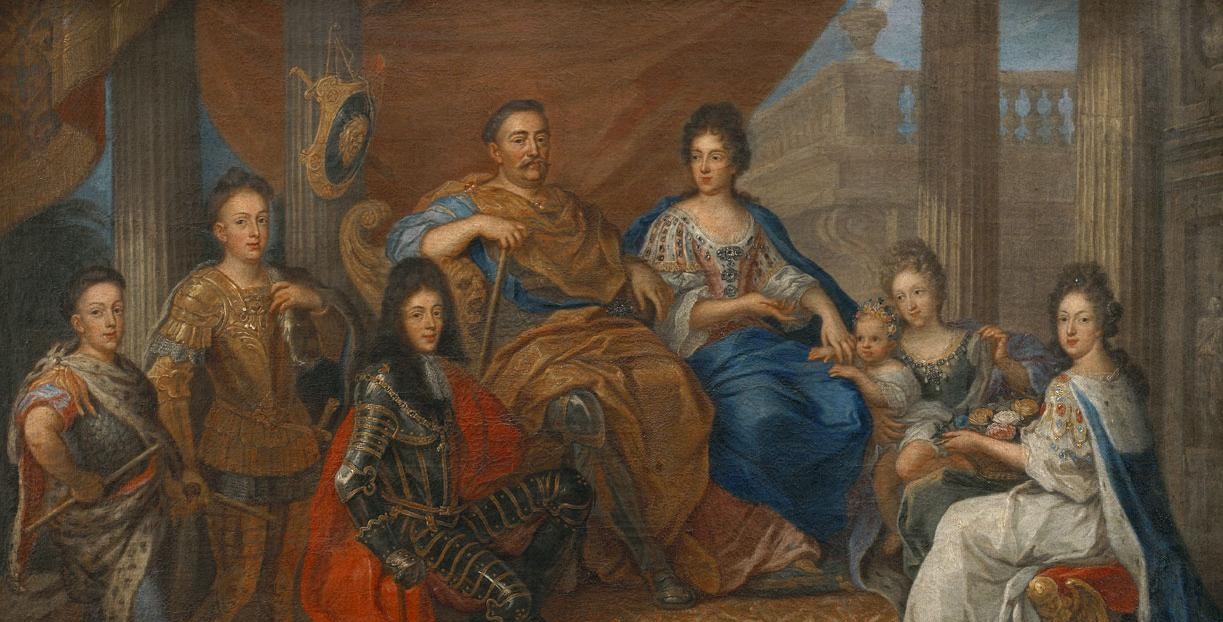Thanks to the long-standing efforts of the Ministry of Culture and National Heritage and the personal involvement of the Deputy Prime Minister/Minister of Culture and National Heritage Professor Piotr Gliński, this summer – after 83 years – a series of seven paintings by members of St Luke’s Brotherhood and four tapestries by Mieczysław Szymański will return to Poland. On 4 May 2022, an agreement was signed at Le Moyne College in Syracuse, USA, under which the works of the former will become part of the Polish History Museum’s collection.
The paintings, which were presented in the Polish pavilion at the New York World’s Fair from May 1939 to the end of 1940, depict the most important events in the history of Poland, showing the country’s contribution to the development of Western civilisation, including its relations with its neighbours, as well its traditions of tolerance and constitutionalism.
Opened by US President Franklin Delano Roosevelt on 30 April 1939, the New York World’s Fair was to present a vision of social progress and technological development under the slogan ‘The World of Tomorrow’. The outbreak of the Second World War made it the finale of the interwar period. Due to the ongoing war in Europe, it was decided that after the end of the exhibition the works from the Polish pavilion were to be stored in the USA. Once the war ended, the paintings and four tapestries by Mieczysław Szymański were placed at the disposal of Stefan Ropp, Commissioner General of the Polish pavilion, who eventually handed the whole collection over to the care of the American college Le Moyne College in Syracuse.
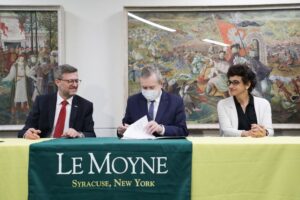
For many years, the idea of returning the paintings to Poland had been present in public debate and in the media. However, it was only in recent years, after talks with Le Moyne College and thanks to the personal involvement of Deputy PM Piotr Gliński, that a common position was reached. Under the agreement, the entire collection will be transferred to Poland. The paintings of St Luke’s brothers and the works of Mieczysław Szymański will become part of the collection of the Polish History Museum as exhibits in its permanent exhibition.
‘This is a special event for Polish heritage. For many years, various circles and institutions have been striving to ensure that the history of the paintings and the tapestries from Le Moyne College is not forgotten. It is our joint success that we are meeting today in Syracuse at Le Moyne College to sign an agreement to transfer the works of Polish artists back to Poland. At this point, I would like to thank once again the authorities of Le Moyne College for their cooperation and understanding of how important these works are to us, and for their many years of care for this unique collection,’ said Deputy PM Piotr Gliński during the ceremony at Le Moyne College. The Minister of Culture and National Heritage expressed special thanks to the people who contributed to the success of the talks with Le Moyne College – Peter Obst and the President of the Polish in America Foundation from Philadelphia, who supported the activities undertaken by the Ministry of Culture and National Heritage in this regard.
I wish to express our deep appreciation to the Polish Government and Minister Gliński for working together to reach this historic agreement,’ said Le Moyne President Linda LeMura. ‘It has been a privilege to host these magnificent works of art displayed on our campus for over six decades,’ she continued.
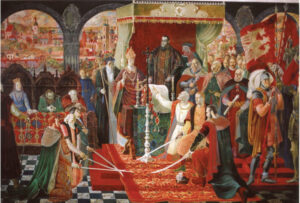
’The paintings and tapestries that have been stored at Le Moyne College are artistically compelling works and an important link in the formation of the Polish historical narrative. Moreover, they document Polish efforts to shape the country’s image abroad. The return of the paintings of St Luke’s brothers is a great achievement and fills yet another gap caused in Polish culture by the Second World War,’ said Director of the Polish History Museum Robert Kostro.
’Stefan de Ropp hoped that these works would one day return to a free Poland,’ stressed Inga Barnello, Director of the Noreen Reale Falcone Library. ‘Le Moyne College is the safest place he could have found for them. I am very pleased to have been able to help look after and educate others about this collection,’ she added.
Over the years, Le Moyne College has taken care to secure and preserve the Polish works. They have been on display in the Noreen Reale Falcone Library since that building opened in 1981, having previously been in the College’s original library on the first floor of Grewen Hall since 1958. According to the agreement, the paintings and tapestries will arrive in Poland later this summer – within 90 days of the signing of the agreement.
History of the collection from Le Moyne College
The Polish pavilion for the 1939 New York World Exhibition was created at a dizzying pace – in less than a year and a half. The exhibition, comprising more than 11,000 objects, was to manifest pride in the cultural and economic achievements of the Polish Second Republic, but also to recall the most important events in Polish history. One of the most interesting elements of the programme of the Hall of Honour in the Polish pavilion was a series of seven paintings representing Poland’s history of many centuries, concentrating in their ideological message on showing the country’s contribution to the development of Western civilisation. This demanding and timely commission was entrusted by the Polish Government in 1938 to a group of eleven artists, students of the School of Fine Arts in Warsaw and members of St Luke’s Brotherhood, among whom were: Bolesław Cybis, Bernard Frydrysiak, Jan Gotard, Aleksander Jędrzejewski, Eliasz Kanarek, Jeremi Kubicki, Antoni Michalak, Stefan Płużański, Janusz Podoski, and Jan Zamoyski. The painters worked under the direction of Professor Tadeusz Pruszkowski in his studio in Kazimierz upon Vistula. The uniqueness of the project stems from the fact that each painting, having eleven co-authors, is a collective artistic work.
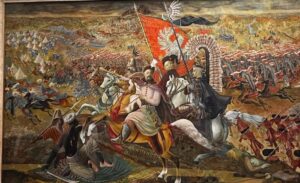
The seven paintings, each measuring 120 x 200 cm, depict momentous events in Polish history: Bolesław the Brave’s meeting of with Otto III at the tomb of St Adalbert (1000), the adoption of Christianity by Lithuania (1386), the granting of the Jedlnia-Krakow privilege (1430), the Union of Lublin (1569), the adoption of the Warsaw Confederation for Religious Freedom (1573), the battle of Vienna (1683), and the Constitution of 3 May (1791). The programme of the series was prepared by a committee of scholars headed by Professor Oskar Halecki. Under his aegis, a thorough search was also carried out, as a result of which the historians helped the painters to recreate the colours and types of fabrics used in the costumes and interiors of past eras. Thanks to the many hours of work each day, the exacting deadline was met. After six months, on 7 December 1938, the effects were presented to the public at the headquarters of the Art Propaganda Institute in Warsaw.
The decoration of the Hall of Honour in the Polish pavilion was complemented by four tapestries entitled Jan III Sobieski, designed by Mieczysław Szymański and made under the direction of Maria Łomnicka-Bujakowa by a team of embroiderers from the Inicjatywa cooperative in Warsaw.
The German invasion in September 1939 meant that the Polish pavilion was deprived of its sources of funding. The Commissioner General of the Polish exhibition, Professor Stefan Ropp, sold off part of the furnishings. Most objects went to the collection of the Polish Museum in Chicago, while the collection of seven paintings by St Luke’s brothers and four tapestries designed by Szymański was deposited at the Jesuit Le Moyne College in Syracuse, New York, where from 1958 it was presented in the local library, initially in Grewen Hall, from 1958 – at the Noreen Reale Falcone Library.
Who were St Luke’s brothers
St Luke’s Brotherhood was an artistic group founded in 1925 focused on traditional figurative painting following in the footsteps of medieval painters’ guilds. It used traditional techniques, referring to Dutch and Italian painting of the 16th-17th centuries. It was founded by Prof. Tadeusz Pruszkowski and his students, who created mainly historical, genre and biblical scenes. They stood in opposition to the avant-garde trends in art prevailing at that time. Members of the St Luke’s Brotherhood included: Bolesław Cybis, Jan Gotard, Aleksander Jędrzejewski, Eliasz Kanarek, Edward Kokoszko, Antoni Michalak, Jan Podoski, Mieczysław Schulz, Czesław Wdowiszewski, Jan Wydra, and Jan Zamoyski. They were later joined by Bernard Frydrysiak, Jeremi Kubicki and Stefan Płużański.
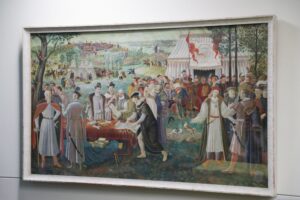
The works which found their way to Le Moyne College find no counterpart in domestic collections in terms of a coherent compositional and ideological programme. They also constitute a valuable record of the creative practice of one of the most interesting Polish artistic groups of the interwar period. The paintings by St Luke’s brothers are also an invaluable testimony to the involvement of the artistic and scientific community in the promotion of Poland during the Second Republic, supported by the generous patronage of the state authorities.
Szymański’s tapestries
Mieczysław Szymański, a Polish painter and textile designer born at the beginning of the 20th century was trained by Professor Tadeusz Pruszkowski. He became famous for a large tapestry made for the World Exhibition in Paris in 1937, for which he received the Grand Prix distinction. Interestingly, it was this very fabric that was later cut into four separate scenes (The Allegory of Victory, The King with Emperor Leopold after the Victorious Battle of Vienna, The King with Marie Casimire Louise de La Grange d’Arquien (Marysieńka) Surrounded by Court Ladies and The Angel) and placed two years later in the Polish pavilion at the World Exhibition in New York.
The series of paintings by St Luke’s Brotherhood will be a valuable addition to the collection of the Polish History Museum. The institution’s collection previously included over 100 objects of applied and folk art from the Polish pavilion donated by Maria Starczewska-Lambasa.
Photo: Danuta Matloch / Ministry of Culture and National Heritage

